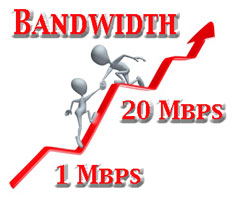Business broadband bandwidth requirements have been on a steady slope upward. Some of this is the change from mostly text based information to graphical and video content. More is due to moving business processes from local desktop computers and company servers to cloud providers. Simple T1 lines and other low speed connections are no longer adequate. Entry level WAN (Wide Area Network) speeds, including Internet broadband, are now in the tens of Megabits per second.
 A popular service level for smaller businesses and remote workers is 20/20 Mbps. This is fast enough to support a single user, small team or small retail location while still being very affordable. Let’s take a look at the options available.
A popular service level for smaller businesses and remote workers is 20/20 Mbps. This is fast enough to support a single user, small team or small retail location while still being very affordable. Let’s take a look at the options available. What is 20/20 Mbps?
The term 20/20 Mbps means 20 Mbps bandwidth in both directions. That’s 20 Mbps upload and 20 Mbps download. When the upload and download speeds are the same, the connection is said to be symmetrical. It makes no difference if you are watching a video clip or backing up files to cloud storage, the bandwidth is the same. In fact, if the connection is full-duplex, as most business grade lines are, you can be downloading and uploading at the same time without slowing down.
Wireline Connections
The 20 Mbps line speed, or bandwidth, is way beyond the capability of a T1 line that runs flat out at 1.5 Mbps. It’s also too much to achieve by bonding multiple T1 lines together. Does that mean that delivery over standard multi-pair telco lines is impossible? Not at all. Newer technology called Ethernet over Copper (EoC) can easily deliver that speed and perhaps even more provided that your business location is close enough to the telephone company office.
Telephone companies own all that twisted pair copper that connects telephone desk sets. The same bundles can carry T1 service and the newer Ethernet over Copper. Regardless of which service provider offers you the EoC service, it will come in on those telco lines. So, the phone company has to have the right termination equipment and you need to be within a couple of miles or so of the office. In populous areas, that’s generally the case.
Fiber Optic Connections
The whole world is converting to fiber at a rapid pace. One of the main drivers is the need for high bandwidth to cellular towers to support 4G and 5G broadband services. The other driver is the ever higher bandwidth requirements of business as cloud services expand.
Fiber is the gold standard of bandwidth connectivity. If you have a fiber optic line installed to your business location, you’ve pretty much future-proofed your business. It’s almost impossible to need more bandwidth than the fiber can support. Even if that happened, there are usually many fiber strands within a fiber optic cable.
Ethernet over Fiber (EoF) is the upgrade to EoC. You can get 20/20 Mbps dedicated, symmetrical bandwidth at a very reasonable price anywhere that fiber is available. Dedicated means that it is for your use only and the line speed doesn’t vary. Both EoF and EoC are dedicated services, although other types of bandwidth might not be.
Another advantage of Ethernet over Fiber is that it is easily scalable. That means that if you get 20/20 Mbps service now and in a few years need to move up to, say 50/50 Mbps because of a growing business, that can be done with a simple phone call to your provider and likely no equipment changes. Some carriers even offer user control panels that let you change bandwidth levels at will.
How about Cable, Satellite and Wireless?
Cable, Satellite and Wireless services have evolved to offer 20/20 Mbps bandwidth and beyond. These services may be less expensive that EoC or EoF, but they are likely to be shared, not dedicated bandwidth and asymmetrical (different upload and download speeds) rather than symmetrical. Satellite and Wireless tend to have some usage limits due to limited resources. In some locations you can get dedicated symmetrical microwave delivery that offers similar performance to EoC or EoF but without the wires.
Are you ready for a bandwidth upgrade but unsure what is the best option for your business? Our knowledgeable consultants can give you good advice and get you the best price on the service you need. Find business bandwidth options over copper, fiber, cable, satellite and wireless now.


